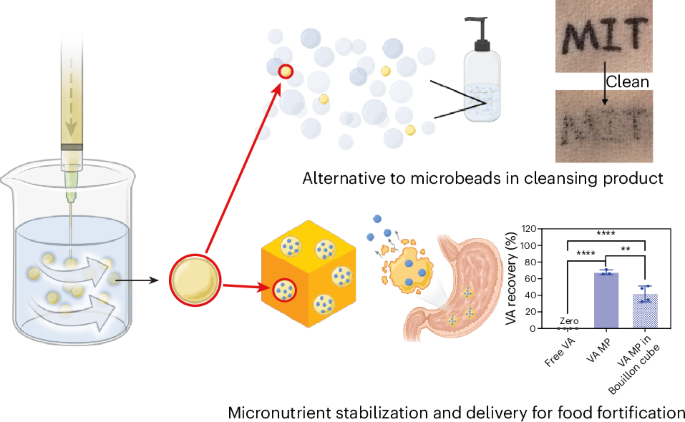2024-12-06 マサチューセッツ工科大学(MIT)
<関連情報>
- https://news.mit.edu/2024/new-biodegradable-material-could-replace-certain-microplastics-1206
- https://www.nature.com/articles/s44286-024-00151-0
- https://www.science.org/doi/10.1126/scitranslmed.aaw3680
クレンジング製品や食品強化のための分解性ポリ(β-アミノエステル)微粒子 Degradable poly(β-amino ester) microparticles for cleansing products and food fortification
Linzixuan Zhang,Ruiqing Xiao,Tianyi Jin,Xinyan Pan,Katharina A. Fransen,Shahad K. Alsaiari,Alicia Lau,Ruizhe He,Jooli Han,Benjamin J. Pedretti,Jing Ying Yeo,Xin Yang,Bradley D. Olsen,Alfredo Alexander-Katz,Zachary P. Smith,Robert Langer & Ana Jaklenec
Nature Chemical Engineering Published:06 December 2024
DOI:https://doi.org/10.1038/s44286-024-00151-0

Abstract
Microplastic pollution is a pressing global crisis caused by the extensive use of nondegradable microplastic materials in daily activities. One effective approach to mitigate this issue is to replace nondegradable plastics with degradable materials that have properties amendable for targeted applications. Here we present the development of a degradable microparticle (MP) platform based on a poly(β-amino ester) (PAE) that degrades into sugar and amino acid derivatives. This PAE MP platform showed functional replacement of nondegradable microplastics used in cleansing products and food fortification. In cleansing products, PAE MPs effectively enhanced the cleansing efficiency of a representative rinse-off product and showed effective removal of potentially toxic elements, as an alternative of traditional nondegradable microbeads. In food fortification, PAE MPs provided robust protection for multiple essential vitamins and minerals against extensive cooking and storage conditions with rapid nutrient release in a simulated human digestion system. Collectively, these PAE MPs present a potential platform to replace microplastic usage on a global scale in many applications.
経口微量栄養素送達のための熱安定性微粒子プラットフォーム A heat-stable microparticle platform for oral micronutrient delivery
Aaron C. Anselmo, Xian Xu, Simone Buerkli, Yingying Zeng, […], and Ana Jaklenec
Science Translational Medicine Published:13 Nov 2019
DOI:https://doi.org/10.1126/scitranslmed.aaw3680
Mitigating micronutrient deficiency
Particularly within the developing world, micronutrient deficiencies that impair growth and contribute to disease remain leading public health concerns. Although fortification of food can help treat deficiencies, heat used during cooking and other conditions can degrade vitamins, preventing adequate absorption. Anselmo and colleagues used the polymer BMC to encapsulate micronutrients. Microparticles encapsulating 11 micronutrients showed improved stability against oxidation, heat (such as boiling water used for cooking), and other conditions, and micronutrients were absorbed by the intestine when microparticles were administered to rodents. Data from two clinical trials and experiments using human intestinal tissue demonstrate how microparticle formulations were optimized to enhance iron loading, improve bioavailability, retain stability against cooking, and allow for scale-up. This microparticle platform could help improve oral delivery of micronutrients.
Abstract
Micronutrient deficiencies affect up to 2 billion people and are the leading cause of cognitive and physical disorders in the developing world. Food fortification is effective in treating micronutrient deficiencies; however, its global implementation has been limited by technical challenges in maintaining micronutrient stability during cooking and storage. We hypothesized that polymer-based encapsulation could address this and facilitate micronutrient absorption. We identified poly(butylmethacrylate-co-(2-dimethylaminoethyl)methacrylate-co-methylmethacrylate) (1:2:1) (BMC) as a material with proven safety, offering stability in boiling water, rapid dissolution in gastric acid, and the ability to encapsulate distinct micronutrients. We encapsulated 11 micronutrients (iron; iodine; zinc; and vitamins A, B2, niacin, biotin, folic acid, B12, C, and D) and co-encapsulated up to 4 micronutrients. Encapsulation improved micronutrient stability against heat, light, moisture, and oxidation. Rodent studies confirmed rapid micronutrient release in the stomach and intestinal absorption. Bioavailability of iron from microparticles, compared to free iron, was lower in an initial human study. An organotypic human intestinal model revealed that increased iron loading and decreased polymer content would improve absorption. Using process development approaches capable of kilogram-scale synthesis, we increased iron loading more than 30-fold. Scaled batches tested in a follow-up human study exhibited up to 89% relative iron bioavailability compared to free iron. Collectively, these studies describe a broad approach for clinical translation of a heat-stable ingestible micronutrient delivery platform with the potential to improve micronutrient deficiency in the developing world. These approaches could potentially be applied toward clinical translation of other materials, such as natural polymers, for encapsulation and oral delivery of micronutrients.



